Diabetic patient has wounds
VerifiedAdded on 2022/08/13
|10
|2953
|13
AI Summary
Contribute Materials
Your contribution can guide someone’s learning journey. Share your
documents today.
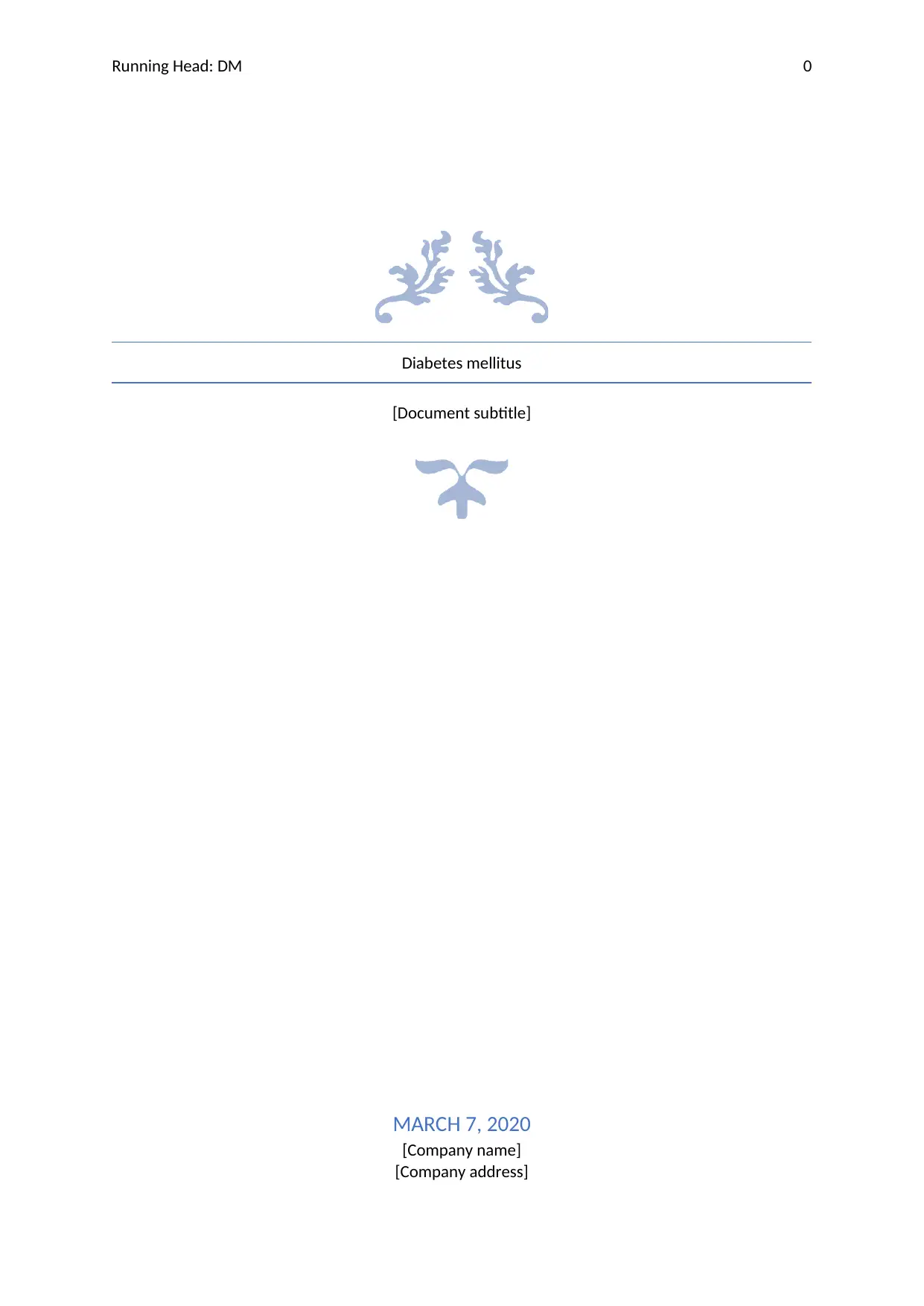
Running Head: DM 0
Diabetes mellitus
[Document subtitle]
MARCH 7, 2020
[Company name]
[Company address]
Diabetes mellitus
[Document subtitle]
MARCH 7, 2020
[Company name]
[Company address]
Secure Best Marks with AI Grader
Need help grading? Try our AI Grader for instant feedback on your assignments.
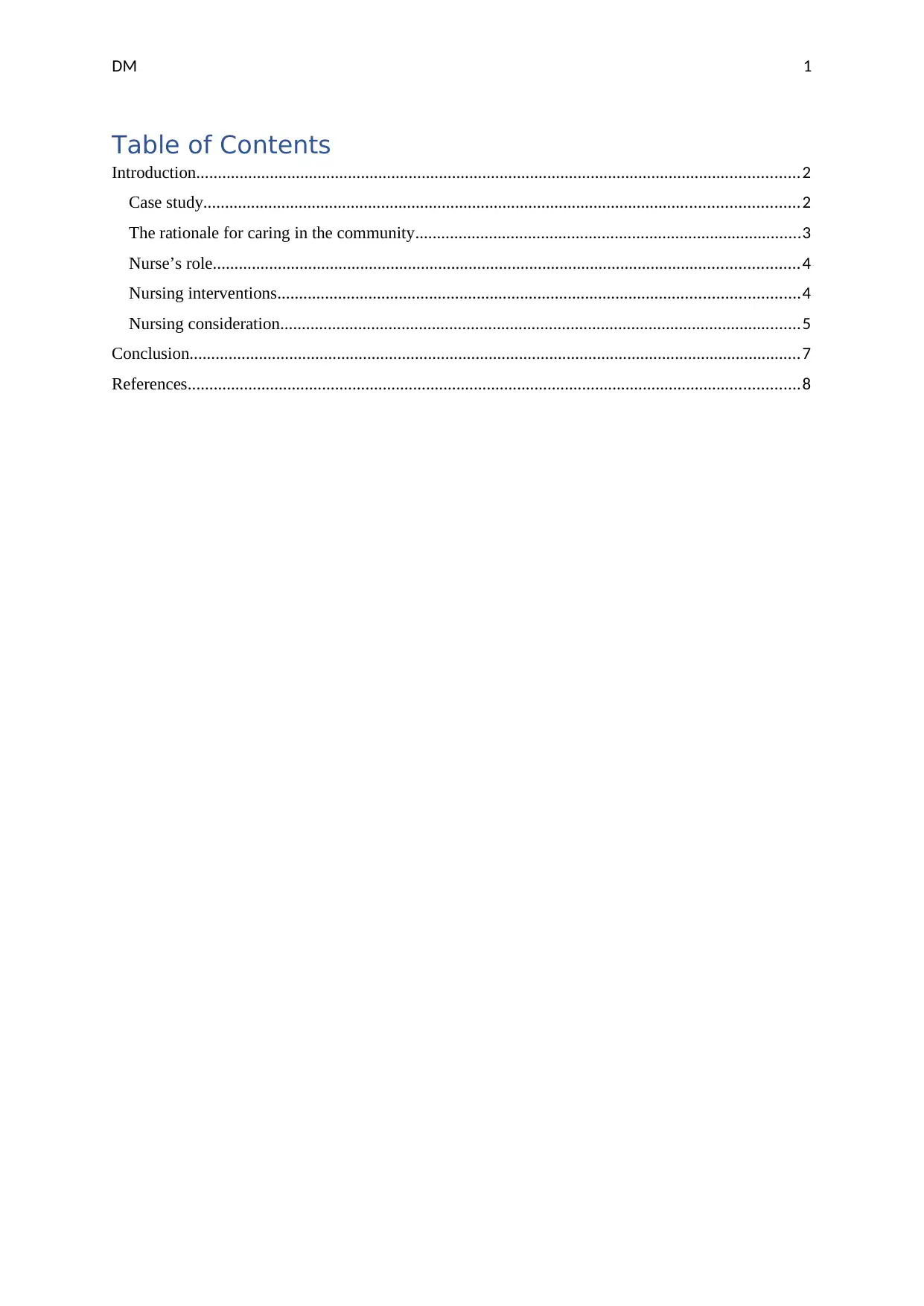
DM 1
Table of Contents
Introduction...........................................................................................................................................2
Case study.........................................................................................................................................2
The rationale for caring in the community.........................................................................................3
Nurse’s role.......................................................................................................................................4
Nursing interventions........................................................................................................................4
Nursing consideration........................................................................................................................5
Conclusion.............................................................................................................................................7
References.............................................................................................................................................8
Table of Contents
Introduction...........................................................................................................................................2
Case study.........................................................................................................................................2
The rationale for caring in the community.........................................................................................3
Nurse’s role.......................................................................................................................................4
Nursing interventions........................................................................................................................4
Nursing consideration........................................................................................................................5
Conclusion.............................................................................................................................................7
References.............................................................................................................................................8
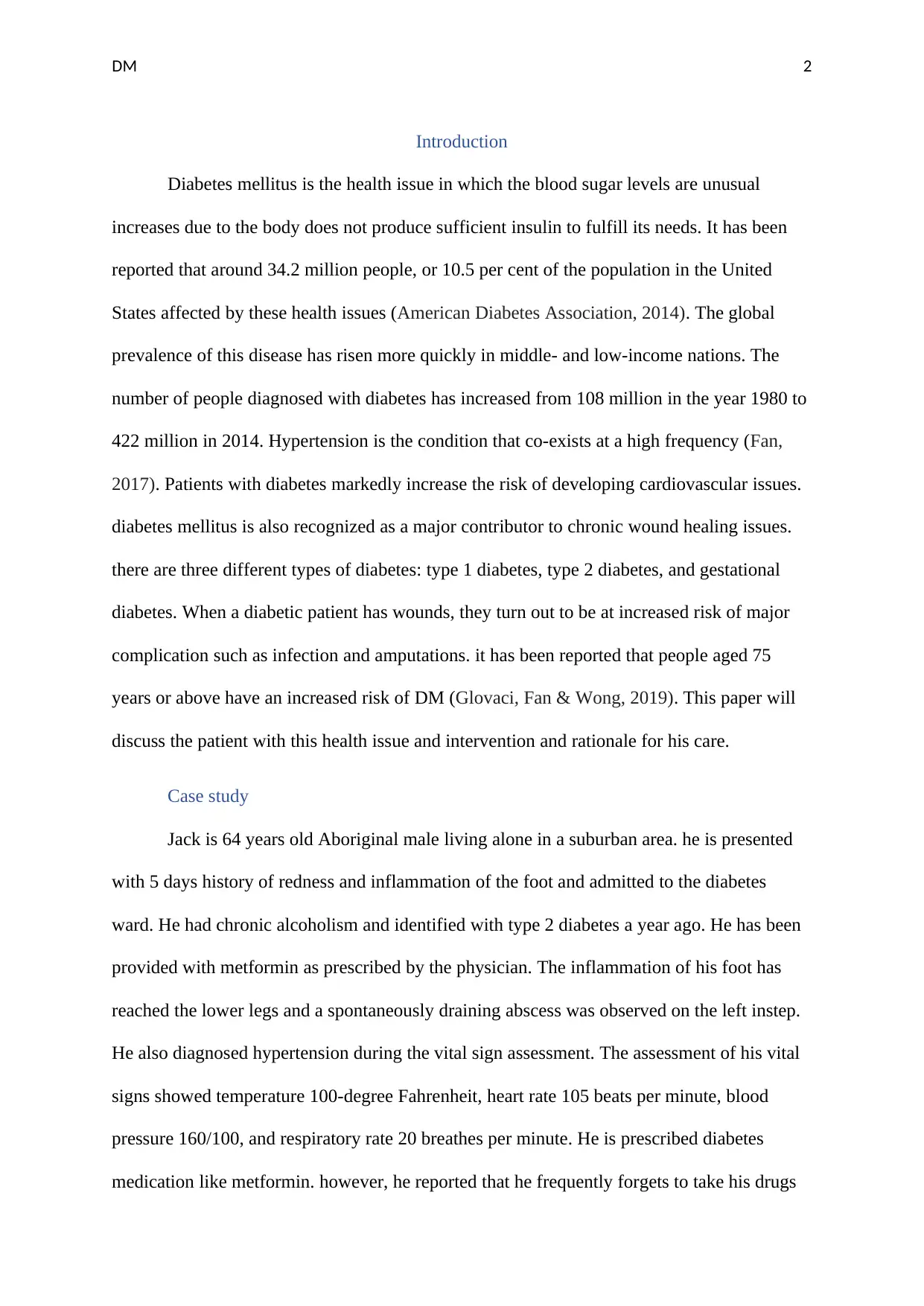
DM 2
Introduction
Diabetes mellitus is the health issue in which the blood sugar levels are unusual
increases due to the body does not produce sufficient insulin to fulfill its needs. It has been
reported that around 34.2 million people, or 10.5 per cent of the population in the United
States affected by these health issues (American Diabetes Association, 2014). The global
prevalence of this disease has risen more quickly in middle- and low-income nations. The
number of people diagnosed with diabetes has increased from 108 million in the year 1980 to
422 million in 2014. Hypertension is the condition that co-exists at a high frequency (Fan,
2017). Patients with diabetes markedly increase the risk of developing cardiovascular issues.
diabetes mellitus is also recognized as a major contributor to chronic wound healing issues.
there are three different types of diabetes: type 1 diabetes, type 2 diabetes, and gestational
diabetes. When a diabetic patient has wounds, they turn out to be at increased risk of major
complication such as infection and amputations. it has been reported that people aged 75
years or above have an increased risk of DM (Glovaci, Fan & Wong, 2019). This paper will
discuss the patient with this health issue and intervention and rationale for his care.
Case study
Jack is 64 years old Aboriginal male living alone in a suburban area. he is presented
with 5 days history of redness and inflammation of the foot and admitted to the diabetes
ward. He had chronic alcoholism and identified with type 2 diabetes a year ago. He has been
provided with metformin as prescribed by the physician. The inflammation of his foot has
reached the lower legs and a spontaneously draining abscess was observed on the left instep.
He also diagnosed hypertension during the vital sign assessment. The assessment of his vital
signs showed temperature 100-degree Fahrenheit, heart rate 105 beats per minute, blood
pressure 160/100, and respiratory rate 20 breathes per minute. He is prescribed diabetes
medication like metformin. however, he reported that he frequently forgets to take his drugs
Introduction
Diabetes mellitus is the health issue in which the blood sugar levels are unusual
increases due to the body does not produce sufficient insulin to fulfill its needs. It has been
reported that around 34.2 million people, or 10.5 per cent of the population in the United
States affected by these health issues (American Diabetes Association, 2014). The global
prevalence of this disease has risen more quickly in middle- and low-income nations. The
number of people diagnosed with diabetes has increased from 108 million in the year 1980 to
422 million in 2014. Hypertension is the condition that co-exists at a high frequency (Fan,
2017). Patients with diabetes markedly increase the risk of developing cardiovascular issues.
diabetes mellitus is also recognized as a major contributor to chronic wound healing issues.
there are three different types of diabetes: type 1 diabetes, type 2 diabetes, and gestational
diabetes. When a diabetic patient has wounds, they turn out to be at increased risk of major
complication such as infection and amputations. it has been reported that people aged 75
years or above have an increased risk of DM (Glovaci, Fan & Wong, 2019). This paper will
discuss the patient with this health issue and intervention and rationale for his care.
Case study
Jack is 64 years old Aboriginal male living alone in a suburban area. he is presented
with 5 days history of redness and inflammation of the foot and admitted to the diabetes
ward. He had chronic alcoholism and identified with type 2 diabetes a year ago. He has been
provided with metformin as prescribed by the physician. The inflammation of his foot has
reached the lower legs and a spontaneously draining abscess was observed on the left instep.
He also diagnosed hypertension during the vital sign assessment. The assessment of his vital
signs showed temperature 100-degree Fahrenheit, heart rate 105 beats per minute, blood
pressure 160/100, and respiratory rate 20 breathes per minute. He is prescribed diabetes
medication like metformin. however, he reported that he frequently forgets to take his drugs

DM 3
and do not think that the drugs are effective in his case. His mental health assessment shows
that he has dementia. He has been living alone after the death of his wife 2 years ago. He is
discharged from the health care setting and receiving nursing care at home in the community.
The rationale for caring in the community
There is a number of benefits of caring about Jack in the community. One of the main
benefits is the comfort. It has been reported that most f the older individuals with diabetes
and other health issues often prefer receiving care in their community (Kirkman et al., 2012).
Older patient prefers to sleep in their own bed, using their own bedroom and perform daily
life works. The familiar surrounding helps them to be recovered from health issues. another
benefit jack will have from community care is the faster recovery. Different researchers
identified that patients with chronic health issues recover faster and more successfully in the
comfort of their homes (Secretariat, 2009). There is also a reduced risk of developing
infections that happen due to exposure to germs in the clinical setting. The cost-effectiveness
of this approach is found to be the most important benefit (Hill, 2019). Jack is already living
alone with limited financial resources; thus, he will not have to pay hospital bills and can
receive personalized care at his home. older individuals are prone to be irritated with hospital
noise, thus receiving diabetes care at home can help Jack to have peace of mind. Loss of
independence is a major issue for older individuals. Therefore, providing care in the
community can help the patient to have his independence (Rad et al., 2013). Its has been
reported that seniors with chronic health issues often experience social isolation and
loneliness feeling which can result in deterioration. By receiving the care in the community
Jack is able to remain in the community and have social support from the neighbors. As ac is
diagnosed with dementia, social support can help him to recover from the mental health issue.
and do not think that the drugs are effective in his case. His mental health assessment shows
that he has dementia. He has been living alone after the death of his wife 2 years ago. He is
discharged from the health care setting and receiving nursing care at home in the community.
The rationale for caring in the community
There is a number of benefits of caring about Jack in the community. One of the main
benefits is the comfort. It has been reported that most f the older individuals with diabetes
and other health issues often prefer receiving care in their community (Kirkman et al., 2012).
Older patient prefers to sleep in their own bed, using their own bedroom and perform daily
life works. The familiar surrounding helps them to be recovered from health issues. another
benefit jack will have from community care is the faster recovery. Different researchers
identified that patients with chronic health issues recover faster and more successfully in the
comfort of their homes (Secretariat, 2009). There is also a reduced risk of developing
infections that happen due to exposure to germs in the clinical setting. The cost-effectiveness
of this approach is found to be the most important benefit (Hill, 2019). Jack is already living
alone with limited financial resources; thus, he will not have to pay hospital bills and can
receive personalized care at his home. older individuals are prone to be irritated with hospital
noise, thus receiving diabetes care at home can help Jack to have peace of mind. Loss of
independence is a major issue for older individuals. Therefore, providing care in the
community can help the patient to have his independence (Rad et al., 2013). Its has been
reported that seniors with chronic health issues often experience social isolation and
loneliness feeling which can result in deterioration. By receiving the care in the community
Jack is able to remain in the community and have social support from the neighbors. As ac is
diagnosed with dementia, social support can help him to recover from the mental health issue.
Secure Best Marks with AI Grader
Need help grading? Try our AI Grader for instant feedback on your assignments.
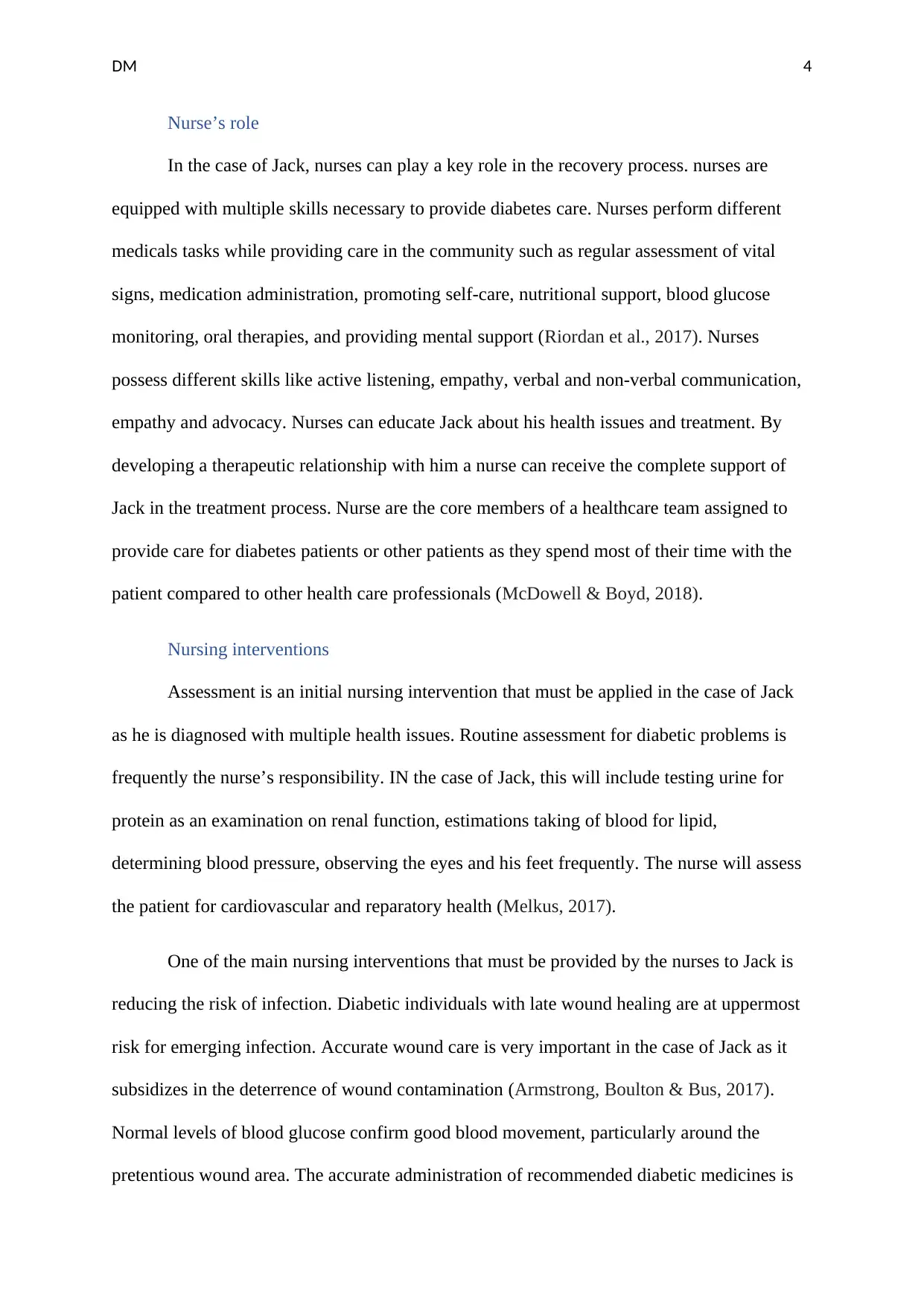
DM 4
Nurse’s role
In the case of Jack, nurses can play a key role in the recovery process. nurses are
equipped with multiple skills necessary to provide diabetes care. Nurses perform different
medicals tasks while providing care in the community such as regular assessment of vital
signs, medication administration, promoting self-care, nutritional support, blood glucose
monitoring, oral therapies, and providing mental support (Riordan et al., 2017). Nurses
possess different skills like active listening, empathy, verbal and non-verbal communication,
empathy and advocacy. Nurses can educate Jack about his health issues and treatment. By
developing a therapeutic relationship with him a nurse can receive the complete support of
Jack in the treatment process. Nurse are the core members of a healthcare team assigned to
provide care for diabetes patients or other patients as they spend most of their time with the
patient compared to other health care professionals (McDowell & Boyd, 2018).
Nursing interventions
Assessment is an initial nursing intervention that must be applied in the case of Jack
as he is diagnosed with multiple health issues. Routine assessment for diabetic problems is
frequently the nurse’s responsibility. IN the case of Jack, this will include testing urine for
protein as an examination on renal function, estimations taking of blood for lipid,
determining blood pressure, observing the eyes and his feet frequently. The nurse will assess
the patient for cardiovascular and reparatory health (Melkus, 2017).
One of the main nursing interventions that must be provided by the nurses to Jack is
reducing the risk of infection. Diabetic individuals with late wound healing are at uppermost
risk for emerging infection. Accurate wound care is very important in the case of Jack as it
subsidizes in the deterrence of wound contamination (Armstrong, Boulton & Bus, 2017).
Normal levels of blood glucose confirm good blood movement, particularly around the
pretentious wound area. The accurate administration of recommended diabetic medicines is
Nurse’s role
In the case of Jack, nurses can play a key role in the recovery process. nurses are
equipped with multiple skills necessary to provide diabetes care. Nurses perform different
medicals tasks while providing care in the community such as regular assessment of vital
signs, medication administration, promoting self-care, nutritional support, blood glucose
monitoring, oral therapies, and providing mental support (Riordan et al., 2017). Nurses
possess different skills like active listening, empathy, verbal and non-verbal communication,
empathy and advocacy. Nurses can educate Jack about his health issues and treatment. By
developing a therapeutic relationship with him a nurse can receive the complete support of
Jack in the treatment process. Nurse are the core members of a healthcare team assigned to
provide care for diabetes patients or other patients as they spend most of their time with the
patient compared to other health care professionals (McDowell & Boyd, 2018).
Nursing interventions
Assessment is an initial nursing intervention that must be applied in the case of Jack
as he is diagnosed with multiple health issues. Routine assessment for diabetic problems is
frequently the nurse’s responsibility. IN the case of Jack, this will include testing urine for
protein as an examination on renal function, estimations taking of blood for lipid,
determining blood pressure, observing the eyes and his feet frequently. The nurse will assess
the patient for cardiovascular and reparatory health (Melkus, 2017).
One of the main nursing interventions that must be provided by the nurses to Jack is
reducing the risk of infection. Diabetic individuals with late wound healing are at uppermost
risk for emerging infection. Accurate wound care is very important in the case of Jack as it
subsidizes in the deterrence of wound contamination (Armstrong, Boulton & Bus, 2017).
Normal levels of blood glucose confirm good blood movement, particularly around the
pretentious wound area. The accurate administration of recommended diabetic medicines is
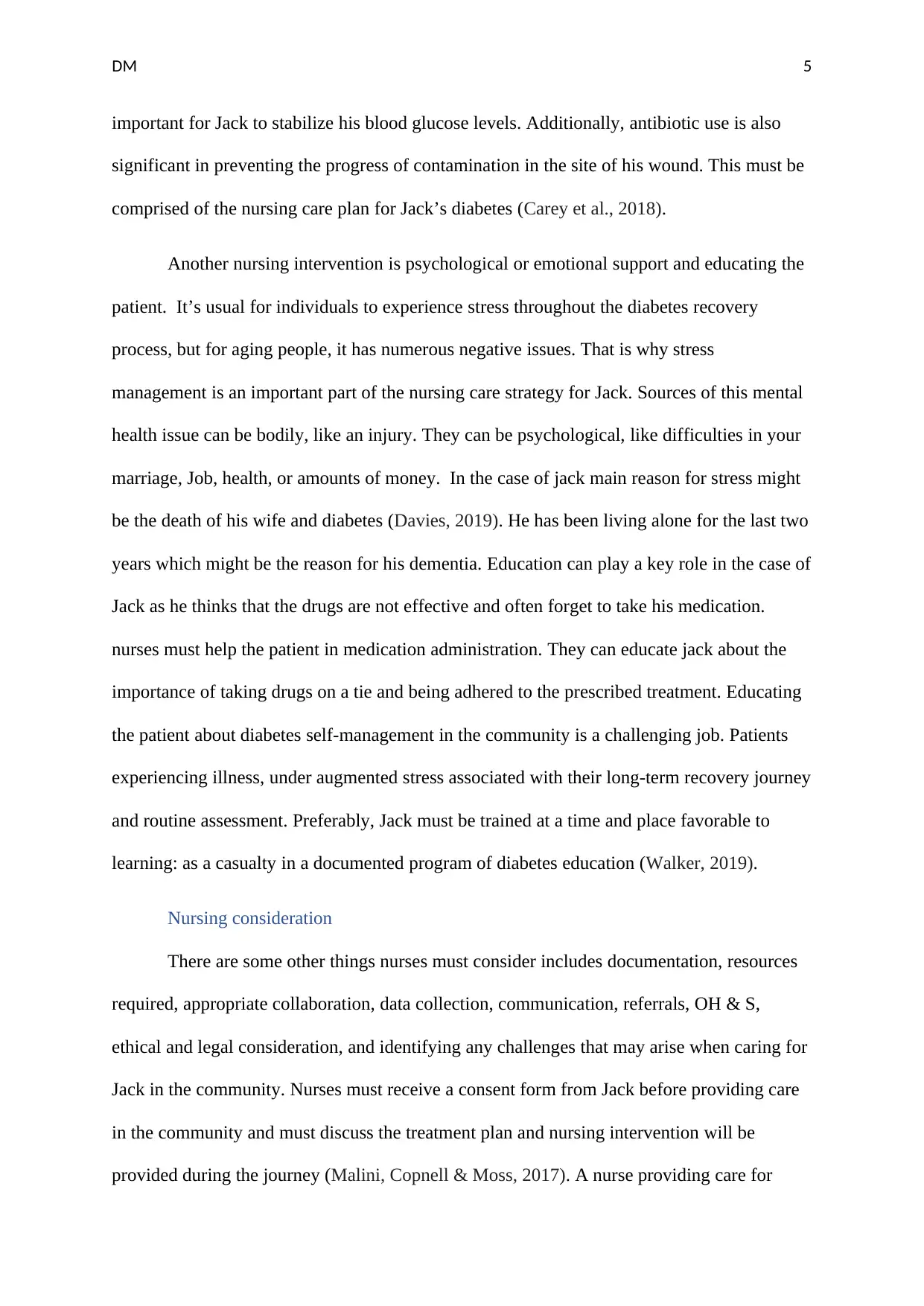
DM 5
important for Jack to stabilize his blood glucose levels. Additionally, antibiotic use is also
significant in preventing the progress of contamination in the site of his wound. This must be
comprised of the nursing care plan for Jack’s diabetes (Carey et al., 2018).
Another nursing intervention is psychological or emotional support and educating the
patient. It’s usual for individuals to experience stress throughout the diabetes recovery
process, but for aging people, it has numerous negative issues. That is why stress
management is an important part of the nursing care strategy for Jack. Sources of this mental
health issue can be bodily, like an injury. They can be psychological, like difficulties in your
marriage, Job, health, or amounts of money. In the case of jack main reason for stress might
be the death of his wife and diabetes (Davies, 2019). He has been living alone for the last two
years which might be the reason for his dementia. Education can play a key role in the case of
Jack as he thinks that the drugs are not effective and often forget to take his medication.
nurses must help the patient in medication administration. They can educate jack about the
importance of taking drugs on a tie and being adhered to the prescribed treatment. Educating
the patient about diabetes self-management in the community is a challenging job. Patients
experiencing illness, under augmented stress associated with their long-term recovery journey
and routine assessment. Preferably, Jack must be trained at a time and place favorable to
learning: as a casualty in a documented program of diabetes education (Walker, 2019).
Nursing consideration
There are some other things nurses must consider includes documentation, resources
required, appropriate collaboration, data collection, communication, referrals, OH & S,
ethical and legal consideration, and identifying any challenges that may arise when caring for
Jack in the community. Nurses must receive a consent form from Jack before providing care
in the community and must discuss the treatment plan and nursing intervention will be
provided during the journey (Malini, Copnell & Moss, 2017). A nurse providing care for
important for Jack to stabilize his blood glucose levels. Additionally, antibiotic use is also
significant in preventing the progress of contamination in the site of his wound. This must be
comprised of the nursing care plan for Jack’s diabetes (Carey et al., 2018).
Another nursing intervention is psychological or emotional support and educating the
patient. It’s usual for individuals to experience stress throughout the diabetes recovery
process, but for aging people, it has numerous negative issues. That is why stress
management is an important part of the nursing care strategy for Jack. Sources of this mental
health issue can be bodily, like an injury. They can be psychological, like difficulties in your
marriage, Job, health, or amounts of money. In the case of jack main reason for stress might
be the death of his wife and diabetes (Davies, 2019). He has been living alone for the last two
years which might be the reason for his dementia. Education can play a key role in the case of
Jack as he thinks that the drugs are not effective and often forget to take his medication.
nurses must help the patient in medication administration. They can educate jack about the
importance of taking drugs on a tie and being adhered to the prescribed treatment. Educating
the patient about diabetes self-management in the community is a challenging job. Patients
experiencing illness, under augmented stress associated with their long-term recovery journey
and routine assessment. Preferably, Jack must be trained at a time and place favorable to
learning: as a casualty in a documented program of diabetes education (Walker, 2019).
Nursing consideration
There are some other things nurses must consider includes documentation, resources
required, appropriate collaboration, data collection, communication, referrals, OH & S,
ethical and legal consideration, and identifying any challenges that may arise when caring for
Jack in the community. Nurses must receive a consent form from Jack before providing care
in the community and must discuss the treatment plan and nursing intervention will be
provided during the journey (Malini, Copnell & Moss, 2017). A nurse providing care for
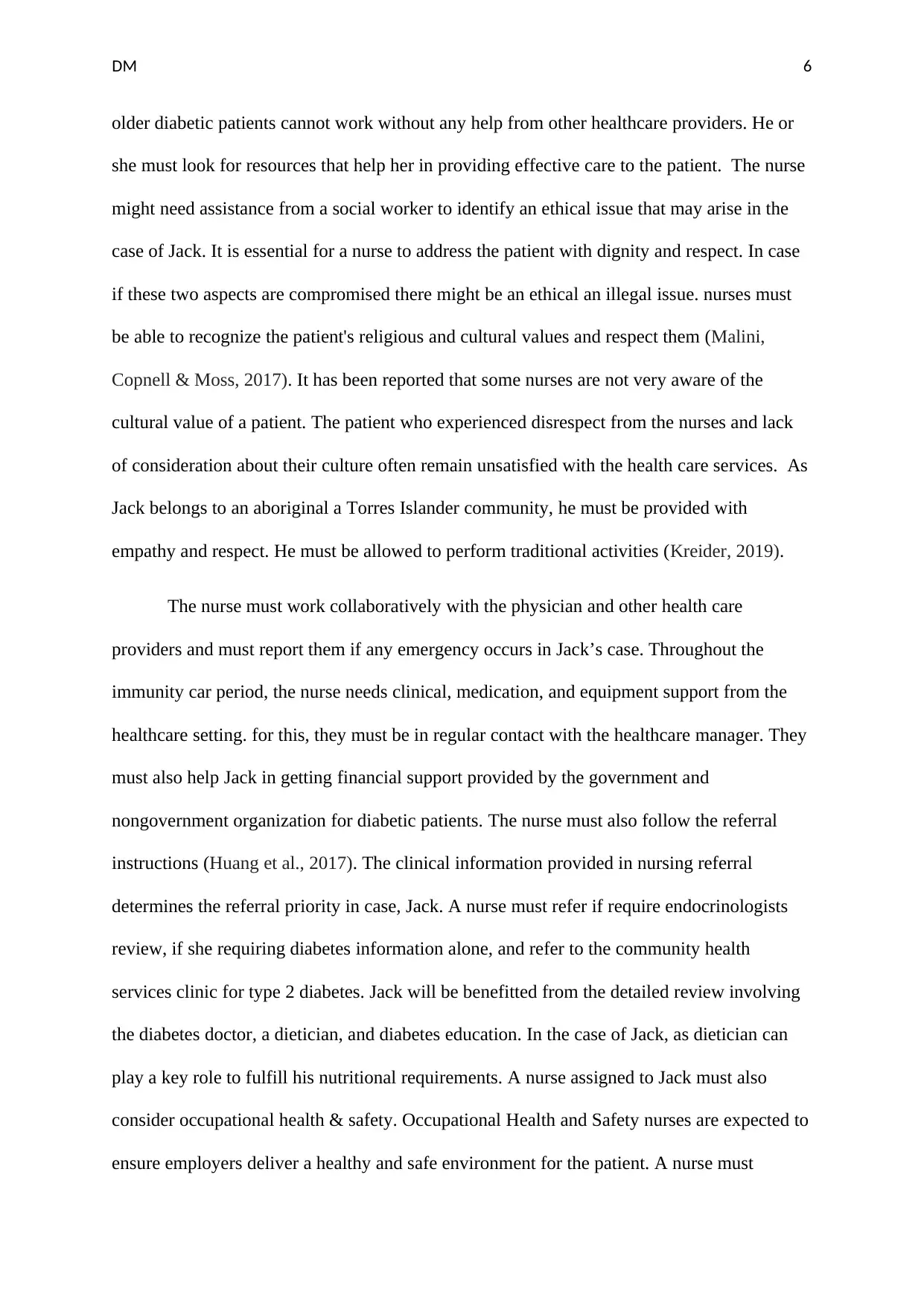
DM 6
older diabetic patients cannot work without any help from other healthcare providers. He or
she must look for resources that help her in providing effective care to the patient. The nurse
might need assistance from a social worker to identify an ethical issue that may arise in the
case of Jack. It is essential for a nurse to address the patient with dignity and respect. In case
if these two aspects are compromised there might be an ethical an illegal issue. nurses must
be able to recognize the patient's religious and cultural values and respect them (Malini,
Copnell & Moss, 2017). It has been reported that some nurses are not very aware of the
cultural value of a patient. The patient who experienced disrespect from the nurses and lack
of consideration about their culture often remain unsatisfied with the health care services. As
Jack belongs to an aboriginal a Torres Islander community, he must be provided with
empathy and respect. He must be allowed to perform traditional activities (Kreider, 2019).
The nurse must work collaboratively with the physician and other health care
providers and must report them if any emergency occurs in Jack’s case. Throughout the
immunity car period, the nurse needs clinical, medication, and equipment support from the
healthcare setting. for this, they must be in regular contact with the healthcare manager. They
must also help Jack in getting financial support provided by the government and
nongovernment organization for diabetic patients. The nurse must also follow the referral
instructions (Huang et al., 2017). The clinical information provided in nursing referral
determines the referral priority in case, Jack. A nurse must refer if require endocrinologists
review, if she requiring diabetes information alone, and refer to the community health
services clinic for type 2 diabetes. Jack will be benefitted from the detailed review involving
the diabetes doctor, a dietician, and diabetes education. In the case of Jack, as dietician can
play a key role to fulfill his nutritional requirements. A nurse assigned to Jack must also
consider occupational health & safety. Occupational Health and Safety nurses are expected to
ensure employers deliver a healthy and safe environment for the patient. A nurse must
older diabetic patients cannot work without any help from other healthcare providers. He or
she must look for resources that help her in providing effective care to the patient. The nurse
might need assistance from a social worker to identify an ethical issue that may arise in the
case of Jack. It is essential for a nurse to address the patient with dignity and respect. In case
if these two aspects are compromised there might be an ethical an illegal issue. nurses must
be able to recognize the patient's religious and cultural values and respect them (Malini,
Copnell & Moss, 2017). It has been reported that some nurses are not very aware of the
cultural value of a patient. The patient who experienced disrespect from the nurses and lack
of consideration about their culture often remain unsatisfied with the health care services. As
Jack belongs to an aboriginal a Torres Islander community, he must be provided with
empathy and respect. He must be allowed to perform traditional activities (Kreider, 2019).
The nurse must work collaboratively with the physician and other health care
providers and must report them if any emergency occurs in Jack’s case. Throughout the
immunity car period, the nurse needs clinical, medication, and equipment support from the
healthcare setting. for this, they must be in regular contact with the healthcare manager. They
must also help Jack in getting financial support provided by the government and
nongovernment organization for diabetic patients. The nurse must also follow the referral
instructions (Huang et al., 2017). The clinical information provided in nursing referral
determines the referral priority in case, Jack. A nurse must refer if require endocrinologists
review, if she requiring diabetes information alone, and refer to the community health
services clinic for type 2 diabetes. Jack will be benefitted from the detailed review involving
the diabetes doctor, a dietician, and diabetes education. In the case of Jack, as dietician can
play a key role to fulfill his nutritional requirements. A nurse assigned to Jack must also
consider occupational health & safety. Occupational Health and Safety nurses are expected to
ensure employers deliver a healthy and safe environment for the patient. A nurse must
Paraphrase This Document
Need a fresh take? Get an instant paraphrase of this document with our AI Paraphraser
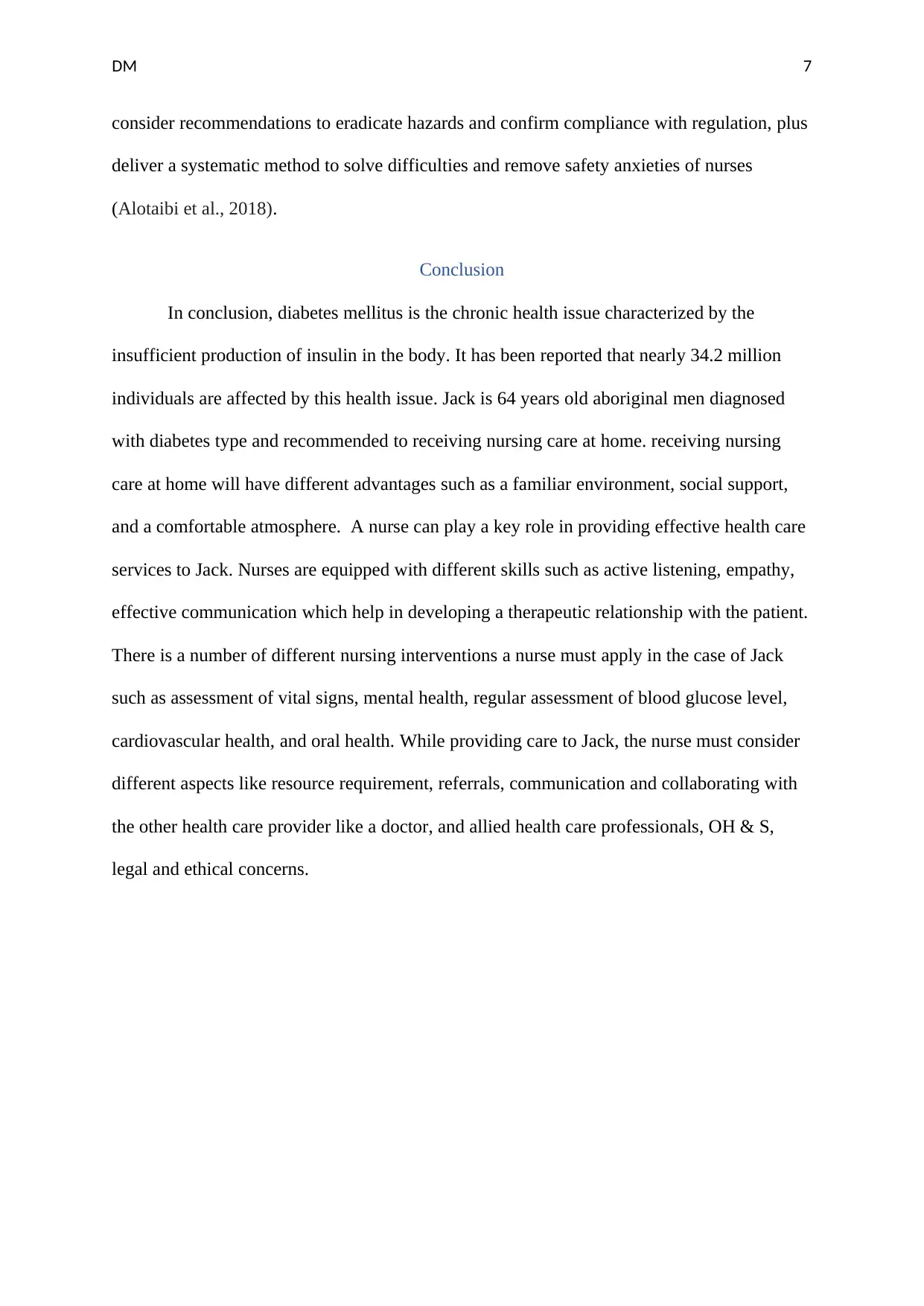
DM 7
consider recommendations to eradicate hazards and confirm compliance with regulation, plus
deliver a systematic method to solve difficulties and remove safety anxieties of nurses
(Alotaibi et al., 2018).
Conclusion
In conclusion, diabetes mellitus is the chronic health issue characterized by the
insufficient production of insulin in the body. It has been reported that nearly 34.2 million
individuals are affected by this health issue. Jack is 64 years old aboriginal men diagnosed
with diabetes type and recommended to receiving nursing care at home. receiving nursing
care at home will have different advantages such as a familiar environment, social support,
and a comfortable atmosphere. A nurse can play a key role in providing effective health care
services to Jack. Nurses are equipped with different skills such as active listening, empathy,
effective communication which help in developing a therapeutic relationship with the patient.
There is a number of different nursing interventions a nurse must apply in the case of Jack
such as assessment of vital signs, mental health, regular assessment of blood glucose level,
cardiovascular health, and oral health. While providing care to Jack, the nurse must consider
different aspects like resource requirement, referrals, communication and collaborating with
the other health care provider like a doctor, and allied health care professionals, OH & S,
legal and ethical concerns.
consider recommendations to eradicate hazards and confirm compliance with regulation, plus
deliver a systematic method to solve difficulties and remove safety anxieties of nurses
(Alotaibi et al., 2018).
Conclusion
In conclusion, diabetes mellitus is the chronic health issue characterized by the
insufficient production of insulin in the body. It has been reported that nearly 34.2 million
individuals are affected by this health issue. Jack is 64 years old aboriginal men diagnosed
with diabetes type and recommended to receiving nursing care at home. receiving nursing
care at home will have different advantages such as a familiar environment, social support,
and a comfortable atmosphere. A nurse can play a key role in providing effective health care
services to Jack. Nurses are equipped with different skills such as active listening, empathy,
effective communication which help in developing a therapeutic relationship with the patient.
There is a number of different nursing interventions a nurse must apply in the case of Jack
such as assessment of vital signs, mental health, regular assessment of blood glucose level,
cardiovascular health, and oral health. While providing care to Jack, the nurse must consider
different aspects like resource requirement, referrals, communication and collaborating with
the other health care provider like a doctor, and allied health care professionals, OH & S,
legal and ethical concerns.

DM 8
References
Alotaibi, A., Gholizadeh, L., Al‐Ganmi, A. H. A., & Perry, L. (2018). Factors influencing
nurses’ knowledge acquisition of diabetes care and its management: A qualitative
study. Journal of clinical nursing, 27(23-24), 4340-4352.
American Diabetes Association. (2014). Diagnosis and classification of diabetes
mellitus. Diabetes care, 37(Supplement 1), S81-S90.
Armstrong, D. G., Boulton, A. J., & Bus, S. A. (2017). Diabetic foot ulcers and their
recurrence. New England Journal of Medicine, 376(24), 2367-2375.
Carey, I. M., Critchley, J. A., DeWilde, S., Harris, T., Hosking, F. J., & Cook, D. G. (2018).
Risk of infection in type 1 and type 2 diabetes compared with the general population:
a matched cohort study. Diabetes Care, 41(3), 513-521.
Davies, M. (2019). Psychological aspects of diabetes management. Medicine, 47(2), 131-134.
Fan, W. (2017). Epidemiology in diabetes mellitus and cardiovascular
disease. Cardiovascular endocrinology, 6(1), 8.
Glovaci, D., Fan, W., & Wong, N. D. (2019). Epidemiology of diabetes mellitus and
cardiovascular disease. Current cardiology reports, 21(4), 21.
Hill, J. (2019). The older person with diabetes: considerations for care. British journal of
community nursing, 24(4), 160-164.
Huang, M. C., Hung, C. H., Yu, C. Y., Berry, D. C., Shin, S. J., & Hsu, Y. Y. (2017). The
effectiveness of multimedia education for patients with type 2 diabetes
mellitus. Journal of advanced nursing, 73(4), 943-954.
References
Alotaibi, A., Gholizadeh, L., Al‐Ganmi, A. H. A., & Perry, L. (2018). Factors influencing
nurses’ knowledge acquisition of diabetes care and its management: A qualitative
study. Journal of clinical nursing, 27(23-24), 4340-4352.
American Diabetes Association. (2014). Diagnosis and classification of diabetes
mellitus. Diabetes care, 37(Supplement 1), S81-S90.
Armstrong, D. G., Boulton, A. J., & Bus, S. A. (2017). Diabetic foot ulcers and their
recurrence. New England Journal of Medicine, 376(24), 2367-2375.
Carey, I. M., Critchley, J. A., DeWilde, S., Harris, T., Hosking, F. J., & Cook, D. G. (2018).
Risk of infection in type 1 and type 2 diabetes compared with the general population:
a matched cohort study. Diabetes Care, 41(3), 513-521.
Davies, M. (2019). Psychological aspects of diabetes management. Medicine, 47(2), 131-134.
Fan, W. (2017). Epidemiology in diabetes mellitus and cardiovascular
disease. Cardiovascular endocrinology, 6(1), 8.
Glovaci, D., Fan, W., & Wong, N. D. (2019). Epidemiology of diabetes mellitus and
cardiovascular disease. Current cardiology reports, 21(4), 21.
Hill, J. (2019). The older person with diabetes: considerations for care. British journal of
community nursing, 24(4), 160-164.
Huang, M. C., Hung, C. H., Yu, C. Y., Berry, D. C., Shin, S. J., & Hsu, Y. Y. (2017). The
effectiveness of multimedia education for patients with type 2 diabetes
mellitus. Journal of advanced nursing, 73(4), 943-954.
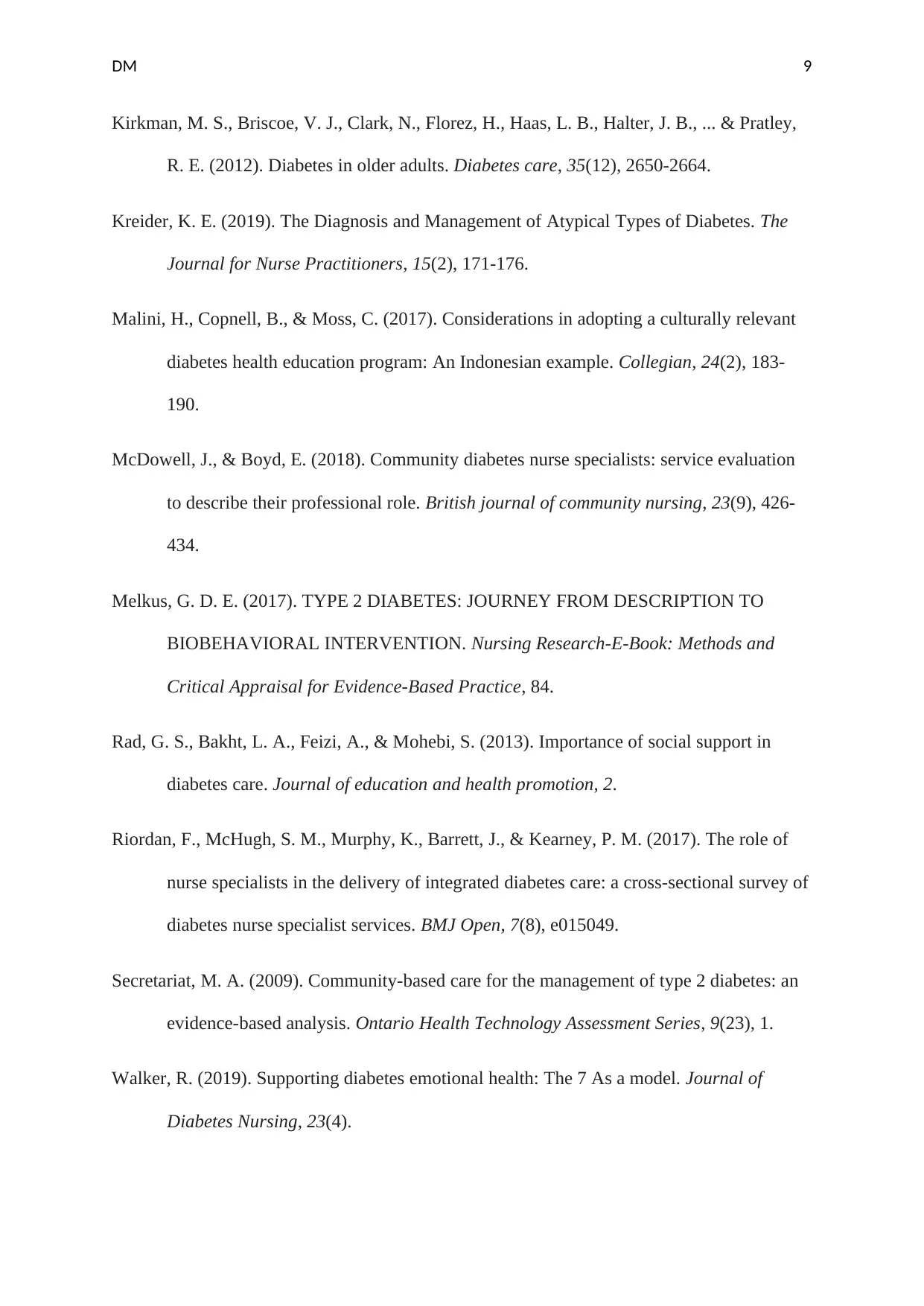
DM 9
Kirkman, M. S., Briscoe, V. J., Clark, N., Florez, H., Haas, L. B., Halter, J. B., ... & Pratley,
R. E. (2012). Diabetes in older adults. Diabetes care, 35(12), 2650-2664.
Kreider, K. E. (2019). The Diagnosis and Management of Atypical Types of Diabetes. The
Journal for Nurse Practitioners, 15(2), 171-176.
Malini, H., Copnell, B., & Moss, C. (2017). Considerations in adopting a culturally relevant
diabetes health education program: An Indonesian example. Collegian, 24(2), 183-
190.
McDowell, J., & Boyd, E. (2018). Community diabetes nurse specialists: service evaluation
to describe their professional role. British journal of community nursing, 23(9), 426-
434.
Melkus, G. D. E. (2017). TYPE 2 DIABETES: JOURNEY FROM DESCRIPTION TO
BIOBEHAVIORAL INTERVENTION. Nursing Research-E-Book: Methods and
Critical Appraisal for Evidence-Based Practice, 84.
Rad, G. S., Bakht, L. A., Feizi, A., & Mohebi, S. (2013). Importance of social support in
diabetes care. Journal of education and health promotion, 2.
Riordan, F., McHugh, S. M., Murphy, K., Barrett, J., & Kearney, P. M. (2017). The role of
nurse specialists in the delivery of integrated diabetes care: a cross-sectional survey of
diabetes nurse specialist services. BMJ Open, 7(8), e015049.
Secretariat, M. A. (2009). Community-based care for the management of type 2 diabetes: an
evidence-based analysis. Ontario Health Technology Assessment Series, 9(23), 1.
Walker, R. (2019). Supporting diabetes emotional health: The 7 As a model. Journal of
Diabetes Nursing, 23(4).
Kirkman, M. S., Briscoe, V. J., Clark, N., Florez, H., Haas, L. B., Halter, J. B., ... & Pratley,
R. E. (2012). Diabetes in older adults. Diabetes care, 35(12), 2650-2664.
Kreider, K. E. (2019). The Diagnosis and Management of Atypical Types of Diabetes. The
Journal for Nurse Practitioners, 15(2), 171-176.
Malini, H., Copnell, B., & Moss, C. (2017). Considerations in adopting a culturally relevant
diabetes health education program: An Indonesian example. Collegian, 24(2), 183-
190.
McDowell, J., & Boyd, E. (2018). Community diabetes nurse specialists: service evaluation
to describe their professional role. British journal of community nursing, 23(9), 426-
434.
Melkus, G. D. E. (2017). TYPE 2 DIABETES: JOURNEY FROM DESCRIPTION TO
BIOBEHAVIORAL INTERVENTION. Nursing Research-E-Book: Methods and
Critical Appraisal for Evidence-Based Practice, 84.
Rad, G. S., Bakht, L. A., Feizi, A., & Mohebi, S. (2013). Importance of social support in
diabetes care. Journal of education and health promotion, 2.
Riordan, F., McHugh, S. M., Murphy, K., Barrett, J., & Kearney, P. M. (2017). The role of
nurse specialists in the delivery of integrated diabetes care: a cross-sectional survey of
diabetes nurse specialist services. BMJ Open, 7(8), e015049.
Secretariat, M. A. (2009). Community-based care for the management of type 2 diabetes: an
evidence-based analysis. Ontario Health Technology Assessment Series, 9(23), 1.
Walker, R. (2019). Supporting diabetes emotional health: The 7 As a model. Journal of
Diabetes Nursing, 23(4).
1 out of 10
Related Documents
Your All-in-One AI-Powered Toolkit for Academic Success.
+13062052269
info@desklib.com
Available 24*7 on WhatsApp / Email
![[object Object]](/_next/static/media/star-bottom.7253800d.svg)
Unlock your academic potential
© 2024 | Zucol Services PVT LTD | All rights reserved.





